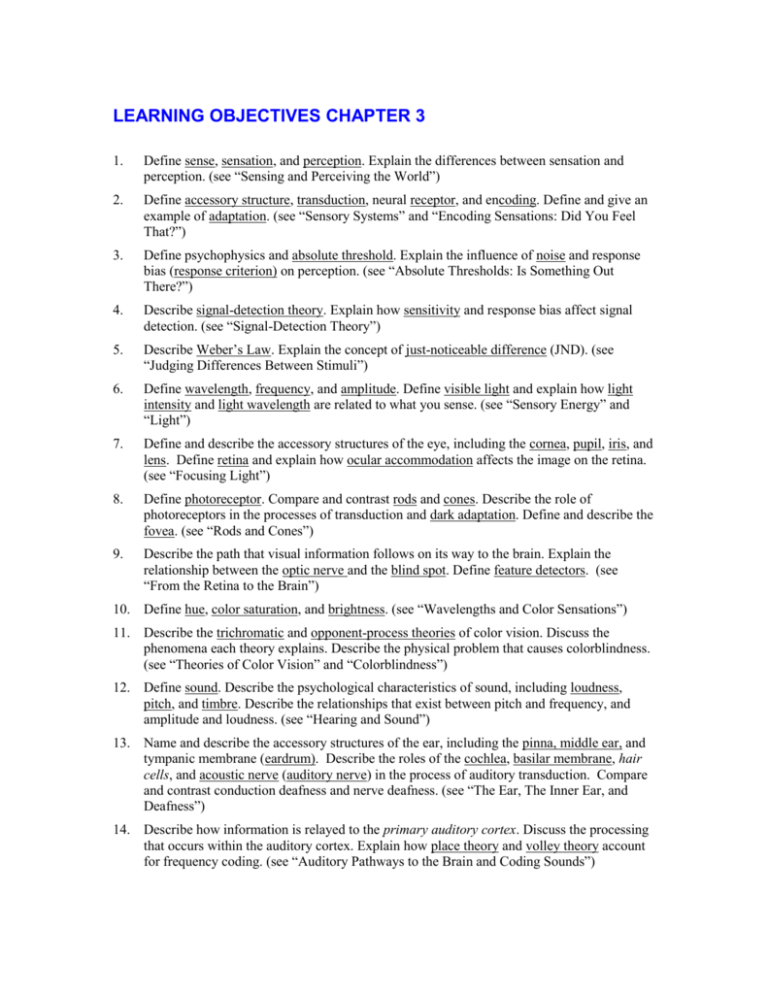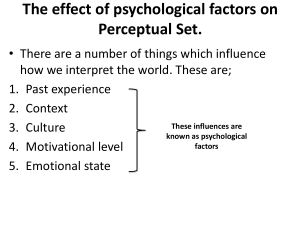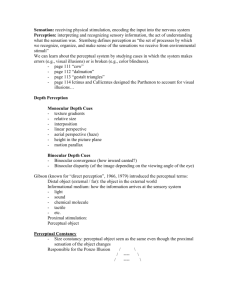LEARNING OBJECTIVESCHAPTER 3
advertisement

LEARNING OBJECTIVES CHAPTER 3 1. Define sense, sensation, and perception. Explain the differences between sensation and perception. (see “Sensing and Perceiving the World”) 2. Define accessory structure, transduction, neural receptor, and encoding. Define and give an example of adaptation. (see “Sensory Systems” and “Encoding Sensations: Did You Feel That?”) 3. Define psychophysics and absolute threshold. Explain the influence of noise and response bias (response criterion) on perception. (see “Absolute Thresholds: Is Something Out There?”) 4. Describe signal-detection theory. Explain how sensitivity and response bias affect signal detection. (see “Signal-Detection Theory”) 5. Describe Weber’s Law. Explain the concept of just-noticeable difference (JND). (see “Judging Differences Between Stimuli”) 6. Define wavelength, frequency, and amplitude. Define visible light and explain how light intensity and light wavelength are related to what you sense. (see “Sensory Energy” and “Light”) 7. Define and describe the accessory structures of the eye, including the cornea, pupil, iris, and lens. Define retina and explain how ocular accommodation affects the image on the retina. (see “Focusing Light”) 8. Define photoreceptor. Compare and contrast rods and cones. Describe the role of photoreceptors in the processes of transduction and dark adaptation. Define and describe the fovea. (see “Rods and Cones”) 9. Describe the path that visual information follows on its way to the brain. Explain the relationship between the optic nerve and the blind spot. Define feature detectors. (see “From the Retina to the Brain”) 10. Define hue, color saturation, and brightness. (see “Wavelengths and Color Sensations”) 11. Describe the trichromatic and opponent-process theories of color vision. Discuss the phenomena each theory explains. Describe the physical problem that causes colorblindness. (see “Theories of Color Vision” and “Colorblindness”) 12. Define sound. Describe the psychological characteristics of sound, including loudness, pitch, and timbre. Describe the relationships that exist between pitch and frequency, and amplitude and loudness. (see “Hearing and Sound”) 13. Name and describe the accessory structures of the ear, including the pinna, middle ear, and tympanic membrane (eardrum). Describe the roles of the cochlea, basilar membrane, hair cells, and acoustic nerve (auditory nerve) in the process of auditory transduction. Compare and contrast conduction deafness and nerve deafness. (see “The Ear, The Inner Ear, and Deafness”) 14. Describe how information is relayed to the primary auditory cortex. Discuss the processing that occurs within the auditory cortex. Explain how place theory and volley theory account for frequency coding. (see “Auditory Pathways to the Brain and Coding Sounds”) 15. Describe olfactory perception (olfaction or sense of smell) and taste perception (gustatory perception). Describe their associations with flavor, emotion, and food preferences. (see “The Chemical Senses: Taste and Smell and Smell, Taste, and Flavor”) 16. Describe the accessory structures and the process of transduction for the sense of smell. Discuss the path that olfactory information follows to the brain, including the olfactory bulb. Define pheromones and discuss their impact on human behavior. Define papillae. (see “Our Sense of Smell and Our Sense of Taste”) 17. Define somatic sense (somatosensory sense). Describe the transduction and encoding processes of the cutaneous senses. Describe the pathways that carry sensory information from the skin to the spinal cord and brain. (see “Sensing Your Body, Touch and Temperature, and Pain as an Information System”) 18. Describe the gate-control theory of pain sensation. Define analgesia. Describe the body’s natural analgesic systems. (see “Modulating Pain: The Gate Control Theory and Natural Analgesics”) 19. Describe the evidence concerning acupuncture and the conclusions that are most reasonable about the treatment. (see “Thinking Critically: Does Acupuncture Relieve Pain?”) 20. Define proprioception and kinesthetic perception. Name the sources of kinesthetic information. Describe the types of information that the sense of equilibrium (vestibular sense) provides. Discuss the structures and neural connections associated with the vestibular sense. (see “Sensing Body Position, Kinesthesia, and Balance”) 21. Define and give an example of figure, ground, and figure-ground discrimination. Describe and give examples of each of the following grouping principles: proximity, similarity, continuity, closure, texture, simplicity, common fate, synchrony, common region, and connectedness. (see “Figure and Ground” and “Grouping”) 22. Define depth perception. Describe the stimulus cues that influence depth perception, including interposition, relative size, height in the visual field, linear perspective, reduced clarity, light and shadow, and textural gradient. (see “Perception of Depth and Distance” and “Stimulus Cues”) 23. Describe the depth cues provided by the visual system, including accommodation, eye convergence, and retinal disparity (binocular disparity). (see “Cues Based on Properties of the Visual System”) 24. Define and give an example of looming. Discuss the effects of head, eye, and body movement on motion perception. Describe the stroboscopic illusion of motion. (see “Perception of Motion”) 25. Define perceptual constancy. Give examples of size, shape, and brightness constancy. (see “Perceptual Constancy”) 26. Compare and contrast bottom-up processing and top-down processing. Discuss how schemas, perceptual sets, context, and motivation can influence top-down processing. Describe how top-down and bottom-up processing work together. (see “Bottom-Up Processing,” “Top-Down Processing,” and “Top-Down and Bottom-Up Processing Together”) 27. Describe the impact of culture and experience on perception. (see “Culture, Experience, and Perception”) 28. Describe an infant’s perceptual abilities and the methods used to study them. (see “Linkages: Perception and Human Development”) 29. Define attention. Give examples of overt and covert orienting, and voluntary and involuntary control. Describe how attention is selective and can lead to inattentional blindness. Describe factors that affect the ability to direct or divide attention. Describe the research involving reaction time and PETs. (See “Attention,” “Directing Attention,” “Dividing Attention,” and “Focus on Research: Attention and the Brain”)






